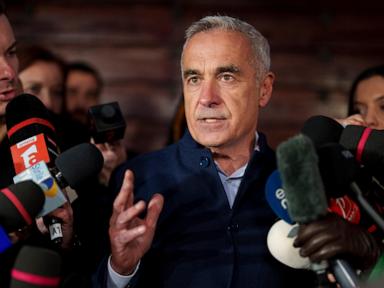ARTICLE AD BOX
EUROPE’S first futuristic hyperloop is one step closer to completion as engineers believe it can achieve its first high-speed run this summer.
The European Hyperloop Centre (EHC), based in Groningen, Netherlands, announced the completion of its 1,377-foot-long hyperloop test infrastructure earlier this year.
 Hyperloop
Hyperloop European Hyperloop Centre
European Hyperloop Centre European Hyperloop Centre
European Hyperloop CentreIt’s hoped that the space-age loop will be able to transport commuters between cities in just minutes and eventually reach speeds of 745mph – faster than a plane.
This would also see passengers zipped from Amsterdam to Barcelona in just a couple of hours, while Paris to Berlin could take half that time.
The experience of travelling inside the hyperloop will be a cross between travelling on a train and plane – there is capacity for a high number of passengers, yet you won’t feel the electric speeds at which you are moving.
And despite Europe’s first full-scale test track having only just opened this year, experts estimate hyperloop to be a reality by 2030.
But the inclusion of a full lane switch and a diverging branch on the EHC’s test track means it can demonstrate all the essential hyperloop technologies.
A highly intricate yet essential step for the realisation of hyperloop networks, the mechanism allows scientists to test what happens when a vehicle changes course at high speeds.
When the track splits, it allows the pod to either go straight or take the curve at a speed of 46-62mph, with the crucial aspect of not hitting the track.
Sascha Lamme, director of the European Hyperloop Centre, has praised the “unique” addition that sets the EHC’s test track aside from the rest across the world.
“Most of the (hyperloop) infrastructure that’s been built in Europe is just a straight pipe, it’s a straight line,” he told The Sun: “In our case, we have this diverging branch.
“It’s very simple. What makes the switch and hyperloop unique is that there’s no moving component.
“Usually, if a train wants to move from one set of tracks to another set of tracks, they have this mechanical component that needs to move.
“It often gets stuck or breaks. They’re quite unreliable.
“It’s basically a mechanism that is completely passive, and that’s what we have built at the European Hyperloop Centre.”
The opening of the test track at the EHC comes more than ten years after Elon Musk first proposed the idea of a high-speed transportation system in 2013.
Using capsules supported by an air-bearing surface within a low-pressure tube, the hyperloop will be able to transport passengers to cities, countries and even continents in short periods of time.
The travel pods will rely on residual air pressure inside the tube to provide lift and propulsion, enabling it to move at lightning-quick speeds.
The ultimate aim is for the technology to produce potential speeds of up to 1,200km/h (745mph), making it faster than a plane.
The passenger capacity of the pods will also be “high” and can “easily compete with that of rail”, according to Lamme.
“Long distance travel is hyperloop’s strong point but it can also be used for short distances, it’s very scalable,” he said.
“A distance of 100km (62 miles) would take you maybe an hour by train – if you can reduce this to 30 minutes or 20 minutes, even, which should be doable at hyperloop, there’s still a huge gain.
“Everyone is willing to travel one and a half hours, but people will definitely be willing to travel just 20 minutes for work.”
What is a Hyperloop?
ELON Musk's outlandish dream of a revolutionary transport system is slowly coming to pass.
The futuristic Hyperloop concept he created in 2013 has been successfully tested and received massive investment from Virgin’s Richard Branson.
When proposing the idea, Musk described the transport system as “a cross between a Concorde, a railgun and an air hockey table”.
The hyperloop would enable passengers to travel in pods which levitate inside massive tubes.
The tubes are surrounded by a cushion of air which drastically reduces friction.
The friction-less pods are able to safely travel at immensely high speeds – similar to how a puck glides in a game of air hockey.
The pods will be propelled either by magnets (a system called passive magnetic levitation) or air expelled from the vessels themselves.
The tubes would be suspended off the ground to protect against weather conditions and earthquakes.
Musk proposed the Hyerploop in a paper that he published for free online, challenging engineers to develop the technology.
In 2014, Richard Branson and Virgin invested in Hyperloop One, which has now been renamed “Virgin Hyperloop”.
Virgin Hyperloop, previously known as Hyperloop Technologies, completed the first public test of the propulsion system in May 2016.
Canada’s Transpod and Spain’s Zeleros also aim to upend traditional passenger and freight networks with similar technology.
Lamme is also confident people will be able to live and work in two separate cities due to the ultraquick journey times.
“It will change people’s ways with how we live within a continent,” he said.
“You could walk to the station, jump on a hyperloop, and within 40 minutes you’re in another country.
“We could build a hyperloop where you can live up to 200km away from where you work.
“We can use space more efficiently and not everyone will have to live in the city centre.
“That’s suddenly become possible, so it’s very strange. How we could live is hard to imagine.”
Hyperloop is also entirely electric, green and uses very little space – a major factor for somewhere as densely packed as Europe.
The energy use of travelling with a hyperloop is estimated to be 10x less compared to traveling by car or by plane, providing an energy-efficient solution for the growing transportation needs.
Furthermore, it produces barely any sound.
“You can literally stand next to the pipe, where a vehicle going 700kmh is rushing by, and you will barely notice,” said Lamme.

 Hardt Hyperloop
Hardt Hyperloop Hyperloop
Hyperloop Hardt Hyperloop
Hardt Hyperloop“This is something that is just not possible with an aeroplane or a train.
“No one is going to live close to an airport, no one wants to live close to a rail line because the sound just blows you away, so integrating hyperloop should be quite a lot easier.”
While there is plenty of hype over hyperloop being introduced within the next ten years, Lamme is instead focused on what can be achieved in the immediate future.
Initial testing on the newly opened track at the EHC will begin this month, with speeds of at least 62mph hopefully achieved by the end of summer.
Lamme told The Sun: “In 12 months, absolutely the first test program should have been completed, so at that point in time I expect all the main technologies to be reliable.
“We should also be able to prove its efficiency and performance, along with achieving a desired level of levitation.
“In the meantime, we want to start with the second test programme with other partners in the European Hyperloop Centre.
“The next step is to work with other companies and have them come and test at our facility.”
He added: “Slowly, the testing will build up, and then during the end of summer I expect proper automotive speeds to be reached.”
Hardt Hyperloop, a leading innovator in the field, is set to commence its first tests in the coming weeks following the completion of its pod.
 European Hyperloop Centre
European Hyperloop Centre Hardt Hyperloop
Hardt Hyperloop European Hyperloop Centre
European Hyperloop Centre“The current outlook is that they will show up with their vehicle at the end of April and do the first tests,” Lamme revealed to The Sun.
“But they’re not going to just show up with their vehicle and it’s going to go 100kmh (62mph), that’s not how it works.
“They’re going to come with their vehicle and, first, carefully levitate the vehicle and see if the levitation works.
“If that works reliably, they will check if the guidance system keeps the vehicle stable in the sideways direction, and check the communications systems don’t lose communication in certain locations.”
In order to achieve the ambitious goal of bringing hyperloop into reality by 2030, however, the EHC would require a 10-20km (6-12 mile) certification facility, Lamme explains.
Alongside the European Commission, the EHC is currently in the preparatory phase of what such a facility would look like.
“We have some quite big ambitions to make it bigger than it currently is,” said Lamme.
“This includes increasing its length, achieving higher speeds and increasing the scale – maybe not directly in the same location, but in the vicinity.
“So there’s quite a lot of things that can still be done.”
However, there are still some additions that can be made to the European Hyperloop Centre without increasing its length.
 A hyperloop vehicle mock-upHyperloop
A hyperloop vehicle mock-upHyperloop Hyperloop
Hyperloop European Hyperloop Centre
European Hyperloop Centre“I think the European Hyperloop Centre in its current state allows us to do a lot of things, for quite a long time,” Lamme said.
“There are so many technologies that can still be incorporated and tested.
“For example, something that is currently not included yet is a charging system.”
Financial support from the European Commission, the Dutch Government and the Province of Groningen has enabled the construction of the current test centre.
But expanding the 1,377ft track will rack up quite a bill, with just 1km (0.6miles) worth of pipes costing an eye-watering €26-27million (£22-£23million).
Despite this, Lamme claims its still cheaper than building more high speed rail tracks – while providing a lot more benefits.
“The energy costs of this system are tremendously lower, like ten times lower, while going at higher speeds,” Lamme explained.
“The maintenance costs of the system are also a lot lower.
“There’s no mechanical contact between the vehicle and the infrastructure, it floats, so there’s also no wear – it’s not like you need to change your tracks all the time.
“The operational costs are what makes it a game changer.”
 European Hyperloop Centre
European Hyperloop Centre European Hyperloop Centre
European Hyperloop Centre Reuters
Reuters.png)
 7 months ago
12
7 months ago
12








 English (US)
English (US)